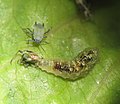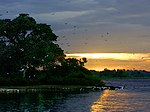 | Cactoblastis cactorum, the cactus moth, South American cactus moth or nopal moth, is native to Argentina, Paraguay, Uruguay and southern Brazil. It is... 32 KB (3,870 words) - 19:33, 20 December 2023 |
 | introduced to help control the spread of the plant, the cactus moth Cactoblastis cactorum, and the scale insect Dactylopius. Between 1926 and 1931, tens of... 90 KB (9,324 words) - 03:40, 7 May 2024 |
 | Cactoblastis cactorum (Berg, 1885) – South American cactus moth Cactoblastis doddi Heinrich, 1939 Cactoblastis mundelli Heinrich, 1939 Cactoblastis ronnai... 1 KB (77 words) - 19:18, 4 January 2021 |
 | them to remain on their land. Detection of the cactus-eating moth Cactoblastis cactorum in Mexico in 2006 caused anxiety among the country's phytosanitary... 8 KB (856 words) - 01:47, 15 April 2024 |
 | down. Cactoblastis cactorum, an agricultural pest introduced to Australia to control invasive cactus species, and commemorated with Cactoblastis Memorial... 7 KB (846 words) - 23:57, 18 October 2023 |
 | Aulacaspis yasumatsui (cycad aulacaspis scale) Cactoblastis cactorum (Cactus moth) Cactoblastis cactorum (cactus moth) Cerataphis lataniae (Palm aphid)... 26 KB (1,890 words) - 17:24, 16 April 2024 |
(solanaceous fruit fly) Blattella germanica (German cockroach) Cactoblastis cactorum (cactus moth) Callinectes sapidus (blue crab) Cerataphis lataniae... 309 KB (23,018 words) - 12:07, 28 April 2024 |
 | 1920s by the deliberate introduction of a South American moth, Cactoblastis cactorum, the larvae of which feed on the cactus. The nopal pear has been... 56 KB (5,967 words) - 12:58, 12 May 2024 |
 | subsequently legalised for the control of wild rabbits. The moth Cactoblastis cactorum was introduced for the control of prickly pear, and the salvinia... 49 KB (4,390 words) - 01:40, 5 March 2024 |
(solanaceous fruit fly) Blattella germanica (German cockroach) Cactoblastis cactorum (cactus moth) Callinectes sapidus (blue crab) Cerataphis lataniae... 2 KB (1,089 words) - 18:25, 30 January 2023 |
 | of exposed reefs. This species is threatened by the cactus moth (Cactoblastis cactorum). Majure, L.; Griffith, P.; Gann, G.D. (2017) [amended version of... 2 KB (176 words) - 01:27, 28 November 2022 |
such as arsenic, pitch, and copper. The success of using the moth Cactoblastis cactorum in controlling prickly pears in Australia led to the hope that the... 37 KB (4,327 words) - 11:16, 28 April 2024 |
 | biological control measures have been carried out with the moth Cactoblastis cactorum so far. Manual removal of the cactuses will be impossible as the... 17 KB (1,682 words) - 05:18, 1 November 2023 |
 | spread. The cacti were eventually controlled by an introduced moth (Cactoblastis cactorum) whose larvae fed on the plant, one of the earliest examples of... 81 KB (9,933 words) - 00:14, 30 April 2024 |
 | one found in all members of the genus Opuntia – the cactus moth (Cactoblastis cactorum), an invasive species that arrived to Florida in 1989 and has been... 5 KB (462 words) - 14:03, 2 April 2024 |
yasumatsui (cycad aulacaspis scale) Bemisia tabaci (silverleaf whitefly) Cactoblastis cactorum (cactus moth) Cerataphis lataniae (palm aphid) [5] Ceratitis capitata... 28 KB (2,260 words) - 18:55, 19 April 2024 |
zonata (peach fruit fly) [18] Bemisia tabaci (silverleaf whitefly) Cactoblastis cactorum (cactus moth) [19] Ceratitis capitata (Mediterranean fruit fly)... 16 KB (1,006 words) - 08:17, 18 November 2023 |
University The Cactus-Feeding Phycitinae Potential and risks of biological control of Cactoblastis cactorum (Lepidoptera: Pyralidae) in North America v t e... 1 KB (96 words) - 15:48, 25 April 2024 |
 | United States". The worst immediate threat to the species today is Cactoblastis cactorum, an invasive, non-native species of moth which eats cacti. It is... 5 KB (559 words) - 15:46, 21 December 2023 |
 | vertebrates. Amongst his many other achievements, he described Cactoblastis cactorum, the cactus moth. Berg was a fellow of the Entomological Society... 5 KB (488 words) - 07:23, 10 November 2023 |










